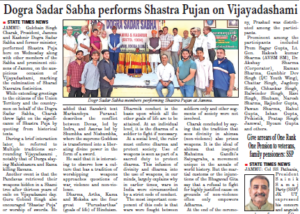Dogra sadar sabha performs shastra pujan on Vijayadashmi
 Th. Gulchain singh charak President Jammu and kashmir Dogra sadar sabha and former Minister , Performed shastra Puja here today Along with Other Members of the Sabha and prominent Citizens of Jammu On occasion of Vijay dashmi ( Dussehra).
Th. Gulchain singh charak President Jammu and kashmir Dogra sadar sabha and former Minister , Performed shastra Puja here today Along with Other Members of the Sabha and prominent Citizens of Jammu On occasion of Vijay dashmi ( Dussehra).
DSS President, Jammu and Kashmir Dogra Sadar Sabha and former minister, performed Shastra Puja here on Wednesday along with other members of the Sabha and prominent citizens of Jammu, on the auspicious occasion of Vijayadashami, markingthe culmination of Sharad Navratra festivities. While extending greetings to the citizens of the Union Territory and the countrymen on behalf of the Dogra Sadar Sabha, Charak threw light on the significance of Shastra Puja by quoting from historical texts. During a brief interaction later, he referred to Multiple traditions surrounding Vijayadasami , notably that of Durga slaying
Mahishasura and Rama killing Ravana. Another event is that the Pandavas retrieved their
weapons hidden in a Shami tree after thirteen years of exile on Vijayadasami day. Guru Gobind Singh also encouraged “Shastar Puja” or worship of swords. He added that Sanskrit text Markandeya Purana1 describes the conflict between Devas, led by Indra, and Asuras led by Shumbha and Nishumbha, where the supreme Goddess is transformed into a liberating
divine power in the form of a sword. He said that it is interesting to observe how a culture
that has a tradition of worshipping weapons approaches questions of war, violence and non-violence. Dharma, Artha, Kama and Moksha are the four great “Purusharthas” (goals of life) of Hinduism. Dharmik conduct is the basis upon which all the other goals of life are to be
attained. At an individual level, it is the dharma of a soldier to fight if necessary. At a social level, the ruler must enforce dharma and protect society. Use of weapons is seen as part of a
sacred duty to protect dharma. This infusion of divinity and dharma into the use of weapons, in our minds, largely explains why in earlier times, wars in India were circumscribed by a strict code of conduct. The most important component of this code is that wars were fought between soldiers only and other segments of society were not involved. Charak concluded by saying that the tradition that sees divinity in ahimsa (non-violence) also prizes weapons. It is the ideal of ahimsa that inspired Mahatma Gandhi’s Satyagraha, a movement unique in the annals of world history. But the martial customs or the injunctions of the Bhagavad Gita say that a refusal to fight for highly justified cause on grounds of non-violence often only empowers A dharma. ,


Leave a Reply